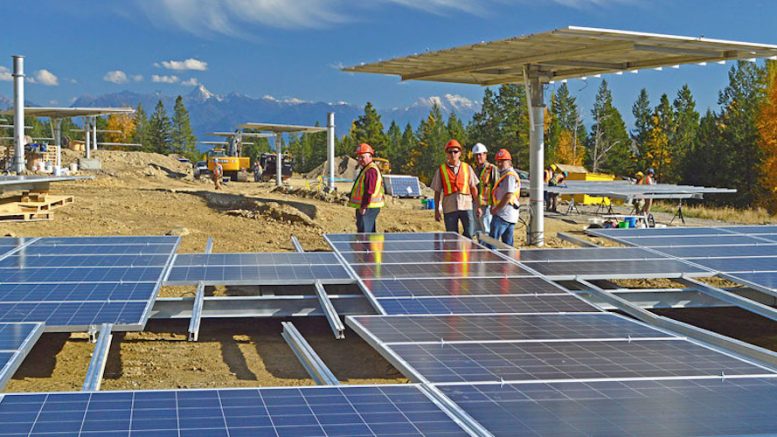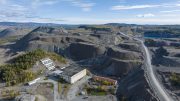The availability of risk capital for miners is biased towards those with concrete plans for achieving net-zero emissions targets by 2030, says Keith Russell, global director for energy transition, purpose and performance with Partners in Performance.
Russell emphasizes the need for decarbonization strategies to become mainstream and incorporated into the industry’s routine management, operating and governance systems.
“I think there’s an element where this has been top-down driven. In other words, boards and CEOs are responding to market and stakeholder pressure, and therefore making sure that the organization’s stated targets are aligned accordingly,” Russell explained in an interview with The Northern Miner.
“We need to ensure those targets are incorporated into the normal business processes. Site managers would become more accountable for preventable site emissions, and via measured, consistent reporting, these initiatives should get incorporated into the investment decision process as companies look at undertaking sustaining capital projects,” Russell said.
He further explained that the decarbonization trend has been visible in the mining industry for many years, first taking hold to reduce input costs. Energy is a significant input into the cost profile of a mining operation, whether it’s the cost of diesel for power or the cost of an ore-haul trip.
“External investor pressure, the community pressures, government regulation, the Paris Accord – all of these forces are coming together, making the C-suite recognize they need to commit to decarbonize,” Russell said.
With 2030 probably the most unified target the mining industry has ever taken on, Russell believes it is already “well on its way” to achieving the goal of net zero.
The first step for companies considering reducing their site-specific emissions, Russel explains, is to draw up a roadmap to understand the range of opportunities for addressing Scope 1 and Scope 2 emissions.
From there, implementation challenges can be examined.
“What are the project execution challenges? And, importantly, what are the governance changes we need to make? How do we ensure that these 2030 targets are broken down into annual, actionable targets,” Russell said.
Typically, a breakdown for mining entails operators ending up close to a 50-50 mix between their Scope 2 emissions – mainly those associated with the power an operation uses – and Scope 1 emissions related to processing which relies heavily on diesel-fuelled ore haulage.
“For some, the solution is to adopt behind-the-meter solutions such as renewable power sources. One of the good things about the mining industry is that they often have access to significant quantities of land. And that land can often be used for renewable installations,” Russell said.
“Obviously, it depends on where you are. You’ve got to have a mix of solutions to make this work.
According to Russell, a critical choke point for miners is moving away from using diesel-electric ore haulage solutions to more efficient electric trolley ramp installations, so-called ‘railveyors,’ and looking at implementing hydrogen fuel cell-powered haul trucks.
“There’s a lot of work that the OEMs are busily doing on battery trolleys and hydrogen fuel cells that I think has a lot of promise,” Russell said.
However, the analyst is bullish on the industry’s ability to meet the medium-term emissions targets.
“The good news is that most of these solutions tend to be NPV-positive for companies after about 18 months. I do think that the industry can meet these targets. I think that the majors are already making very significant steps toward decarbonization. They have more access to capital,” he said.
Majors in the lead
Large firms such as BHP (NYSE: BHP; LSE: BHP; ASX: BHP) and Fortescue Metals (ASX: FMG) are leading the way in pursuing distinct strategies seeking to capitalize on decarbonization. They aim to achieve this with investments in producing new commodities, namely potash and hydrogen, a recent Fitch Solutions Country Risk & Industry Research report concluded.
Like many other majors, BHP has sought to divest completely from coal, oil, and gas production and has almost succeeded, save for the Mt. Arthur coal mine in New South Wales. No buyer was forthcoming, forcing the company to plan to run the mine until depletion in 2030.
Consequently, fossil fuels’ share of BHP’s EBITDA quickly declined when the pandemic struck as it initially sank energy prices, forcing the firm to come up with a new approach given investor pressures and future demand uncertainty in 2020.
Fortescue is pursuing a similar strategy by investing in early-stage hydrogen projects to accelerate decarbonization for steelmakers who consume its iron ore output and by broadly trading ‘green’ hydrogen in the metallurgical sector.
The company’s hydrogen subsidiary Fortescue Future Industries is investing globally in hydro, wind, geothermal, and solar power. According to Fitch, it is also investigating the feasibility of converting disused mines into hydrogen assets.
For instance, in May 2022, the company announced it was exploring the possibility of converting the Centralia coal power plant in Washington State into a green hydrogen production hub to meet net zero targets in hard-to-abate industries.
The subsidiary is also targeting a 2023 date to make a final investment decision on the Gibson Island green hydrogen project in Queensland, where it would partner with Incitec Pivot to convert its ammonia plant to run on green hydrogen. It uses hydrogen created through electrolysis instead of domestic natural gas, which became unprofitable as energy prices surged in the first half of 2022.
“Many of these projects remain prospective, but industrial applications for hydrogen as an input are expected to grow, especially for firms like Fortescue that have moved into acquiring renewable energy assets or are investing in renewable energy supply chains,” said Fitch analysts.
The expected take-up of hydrogen to replace other fossil fuel inputs in industrial processes and power generation is creating new avenues for diversification because of this shift among junior miners towards pairing financing with ensured end-demand for production.
For instance, PGM miner Sibanye-Stillwater (NYSE: SBSW; JSE: SSW) and refiner Heraeus Precious Metals have agreed to collaborate on research and development for proton exchange membrane electrolyzer catalysts containing PGM metals to secure demand from the expected boom in green hydrogen investment and production.
The two companies will jointly fund their research over the next three years with an agreement to commercialize their findings.
The World Platinum Investment Council forecasts that green hydrogen production could provide between 400,000 and 1.3 million oz. platinum demand per year by 2030, depending on PGMs’ market penetration.
Hazer Group is also pioneering a commercial process for ‘turquoise’ hydrogen production using natural gas and iron, producing comparatively low-carbon hydrogen and high-quality graphite as a by-product that can be used as industrial input.
De-industrialization
Meanwhile, Bank of America (BofA) flagged in an early-August Global Metals Weekly report how the lack of adequate strategic natural gas supplies in Europe was roiling economies against Russia’s war in Ukraine.
The bank wrote that supply disruptions could have significant impacts on regional economies, with economic activity affected by the direct effect of gas shortages along upstream and downstream industries.
“Critically, many basic material producers rely heavily on energy, so any disruptions could quickly percolate through supply chains,” wrote the bank’s UK-based commodity strategist Michael Widmer.
According to BofA data, Europe’s aluminum and steel output has already fallen by more than 10% year on year.
And the European Union has announced a gas reduction plan to acknowledge Russia’s gas supply uncertainty.
However, the bank flagged a reduction in gas supply as particularly challenging for European aluminum smelters; gas shortages may also push electricity prices up further. Also, while closures are possible, they do not come cheap.

Rio Tinto produces some of the highest quality, lowest-carbon footprint aluminum in the world. Credit: Rio Tinto
BofA estimates that restarting an aluminum smelter typically requires outlays between €200 and €400 million ($262.2 to $524.3 million) and takes several months.
Given the tight energy markets, official policy and support can only go so far in keeping metals producers running.
Indeed, hoping for a decline in energy costs may not be the best strategy, BofA suggests.
“Similarly, with ferrous and non-ferrous producers accounting for 13% of total gas consumption; shutting down these operators may alleviate gas shortages quickly, but this would come at a high cost: it would effectively drive the de-industrialization through the closure of basic, but still strategic, industries. If this happens, it would be bullish for both aluminum and steel,” wrote Widmer.







Be the first to comment on "Mining industry on track to meet decarbonization targets, say analysts"